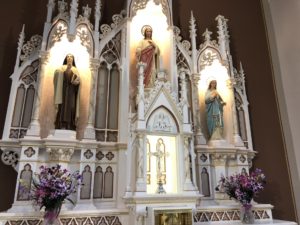LARRY HANSON
CATHOLIC HERALD STAFF
St. Teresa of Avila has always been a strong influence of the small Dodge County community of Theresa  (population 1,262 in 2010).
(population 1,262 in 2010).
The parish (St. Theresa) with 170 families was named after her.
The first three baptisms in the parish were recorded by Fr. Casper Rehrl (who served from 1855-63) as girls named Theresa.
Since 2013, the parish has been aligned with St. Mary of Mayville and St. Andrew of LeRoy, in a grouping that sees the parishes share committees, personnel and resources on everyday parish activities, such as RCIA and CCD.
They are “Three parishes united in faith, fellowship, prayer and service.”
Fr. Tom Biersack, who has been pastor at St. Mary and St. Andrew since 2005, said he likes how the parishes have blended over the past six years.
“If someone moves into town and they go to church once or twice, they’ll call me and say, ‘You’re a really welcoming parish,’” Fr. Biersack said. “All three of these parishes are filled with really good people, people who love God and people who loved their communities and people who reach out, especially to those in need. I’m just really impressed, when I sit down and think about it, with how involved we are and how much our parishes do for not only ourselves, but others. They’re just really good parishes, and really good people.”
The parish was founded by Fr. Francis Xavier Schraudenbach in 1849 and the first services were held in the homes of members of the congregation. The first church, a log frame chapel, was built in the early 1850s.
The first school was built in 1866, but it burned to the ground in 1901 along with a livery stable and a firehouse. The replacement school was built quickly and served the parish until 1960 before being demolished in 1974.
The present building, located at 102 Church St., was completed in 1880 under the watch of Fr. Hermes Hellstern. The building was closed for five months in 2017 for a massive remodeling project that removed some of the floor and wall coverings, restoring the church to its original state.
“Now it’s beautiful, which is another sign of hope for that parish,” Fr. Biersack said.
Fr. Michael Groff was the longest-serving priest in the parish, arriving on Sept. 1, 1896, and staying for the next 55 years. It was the only parish assignment of his career. A large man, Fr. Groff was affectionately known by parishioners as “Father Gruff” because of his style.
In the parish’s sesquicentennial reflection book published in 1999, a parishioner recalled Fr. Groff by saying, “Fr. Groff seemed kind of scary to a 5-year-old, an old man always dressed in black.”
What isn’t scary about the quiet, unassuming parish just off Interstate 41 is how welcoming and involved in the community it is.
“It’s a small town so everybody knows who the Catholics are,” Fr. Biersack said. “They’re very involved with the Firemen’s Picnic, and a few other things they have in town.”
PLAN A VISIT
St. Theresa Parish
102 Church St.
Theresa, WI 53091
920-387-2920
Mass Schedule
Sunday: 9:15 a.m.
WHO WAS ST. TERESA OF AVILA?
Two years after St. Teresa (1515-82) was born, Luther started the Protestant Reformation. Out of all of this change came Teresa pointing the way from outer turmoil to inner peace.
A Carmelite nun, prominent Spanish mystic, religious reformer, author, theologian of the contemplative life and mental prayer, she earned the rare distinction of being declared a Doctor of the Church over four centuries after her death. Active during the Counter-Reformation, she reformed the Carmelite Orders of both women and men. The movement she initiated was later joined by the younger Spanish Carmelite friar and mystic, Saint John of the Cross. It led eventually to the establishment of the Discalced Carmelites. A formal papal decree adopting the split was issued in 1580.
When she was 7 years old, she convinced her older brother that they should “go off to the land of the Moors and beg them, out of love of God, to cut off our heads there.” They got as far as the road from the city before an uncle found them and brought them back.
At the age of 43, she became determined to found a new convent that went back to the basics of a contemplative order: a simple life of poverty devoted to prayer.
